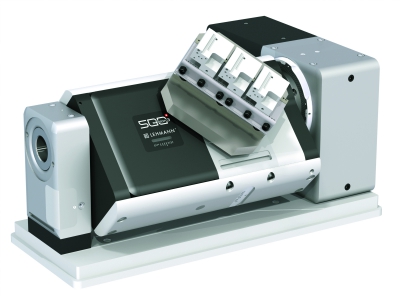
Exsys Tool Inc., which is the exclusive supplier of pL LEHMANN rotary tables for North America, recently announced the expansion of its ultra-high precision products to include the pL LEHMANN swissClamp modular clamping system, according to the San Antonio, Fla.-based company. The modular clamping system reportedly allows operators to mount multiple workpieces on machine tool tables for uninterrupted production and unmanned operations.
For use with rotary and standard tables on vertical or horizontal milling machines, the Swiss-manufactured swissClamp modules mount on face plates or directly on worktables, the comparny reported. The system reportedly extends a shop’s potential part-clamping range from 90mm to 200mm—a 40 percent increase in workpiece capacity within the same clamping length.
The company said swissClamp's four basic modules enable more than 240 possible configurations, including mono clamping, which requires only one basic body, and duo clamping, which involves two mono clamps mounted opposite one another, according to the company.
The system is said to be ideal for a variety of mass production applications in automotive, aerospace, medical/dental and micro technology industries, as well as for strong gripping and light finish clamping applications. For strong gripping, the system achieves rigid, pull-down clamping to depths of 3mm, or 6mm via a mechanical grid on its jaws.
When used for finish clamping, swissClamp’s finish jaws achieve non-rotating, precise parallel clamping with a clamping stroke of approximately 1 mm that prevents indentations and ensures high surface quality. The system enables finish clamping to a depth of 6 mm.
Contact Details
Related Glossary Terms
- gang cutting ( milling)
gang cutting ( milling)
Machining with several cutters mounted on a single arbor, generally for simultaneous cutting.
- milling
milling
Machining operation in which metal or other material is removed by applying power to a rotating cutter. In vertical milling, the cutting tool is mounted vertically on the spindle. In horizontal milling, the cutting tool is mounted horizontally, either directly on the spindle or on an arbor. Horizontal milling is further broken down into conventional milling, where the cutter rotates opposite the direction of feed, or “up” into the workpiece; and climb milling, where the cutter rotates in the direction of feed, or “down” into the workpiece. Milling operations include plane or surface milling, endmilling, facemilling, angle milling, form milling and profiling.
- parallel
parallel
Strip or block of precision-ground stock used to elevate a workpiece, while keeping it parallel to the worktable, to prevent cutter/table contact.







